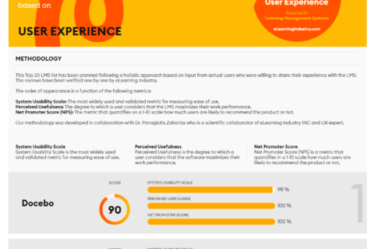Blended Learning is considered the optimal mode for training as it combines the best of two modes – Instructor-Led Training (ILT) sessions with Self-paced and Self-Directed Online Learning.
To match today’s changed workplace dynamics (training remote learners), the concept of Blended Learning 2.0 has emerged. This uses a combination of Virtual Instructor-Led Training (VILT) with Self-paced Online Learning.
Here are the answers to some of the most frequently asked questions on Blended Learning in corporate training.
-
What is Blended Learning?
Blended Learning uses an optimal mix of facilitated (VILT or ILT) sessions with online trainings. It offers a hybrid approach to deliver trainings and is the preferred mode to deliver Virtual Trainings to remote learners in the changed workplace.
-
Why should you use Blended Learning?
The changed workplace and the ongoing need for social distancing have accelerated the need for organizations to re-evaluate classroom training to a virtual or online mode.
Blended Learning is the preferred choice as it uses an ideal mix of facilitated (VILT or ILT) classroom sessions with online trainings to leverage the best of both modes.
-
Is Blended Learning effective?
Blended Learning matches today’s workplace dynamics (remote operations). It provides a median offering of the two modes, VILT sessions with Self-paced Online Learning.
The effectiveness and success of Blended Training hinges on how you arrive at the optimal blend of the two components. It resonates well with today’s multi-generational workforce as it takes lesser time and offers more online choices for remote learners.
-
How can you deliver Blended Learning?
You can use a mix of Instructor-Led Training (ILT)/classroom sessions with online training to deliver Blended Learning.
In today’s context (where learners and trainers necessarily need to connect virtually), you can use a combination of the Virtual Instructor-Led Training (VILT sessions) with Self-paced Online Training.
You can also opt for a Flipped Classroom – where learners watch an online session (VILT – that is live or recorded) and collaborate and have discussions or activities with peers online.
-
How to adopt a Blended Learning approach?
To adopt a Blended Learning approach, you need to create an optimal combination of VILT and Self-paced Online Training (Mobile Learning). You need to:
- Recraft the learning journey by redoing the Training Needs Analysis (TNA) for a Blended Learning Transformation. In this phase, the ILT learning journey is remapped to a Blended Learning delivery.
- Review the content and identify the degree of blend and map it to the learning journey. By focusing on the core learning outcome, an optimal mix and ratio of Blended Training components are decided depending upon the content type, audience, training infrastructure, dedicated time for training, and treatment required for specific learning elements in the original training plan.
- Technology can make or break the learning experience while moving to a Blended approach. Validate the readiness of technology, its accessibility, and its suitability to deploy the trainings. Select a feature-rich modern platform that facilitates collaboration and enables interactive virtual classroom sessions.
- As you re-map the existing classroom to a new learning environment, you should provide adequate measures to educate the remote learners on how they can leverage Virtual Training. Conduct sessions on how to use the tools and technologies used to conduct virtual classrooms.
- Just like the learners, the ILT trainers might find it difficult to conduct sessions virtually. Upskill the trainers so that they can leverage the Virtual Training platform and conduct sessions remotely.
-
What are the different types of Blended Learning?
The success of Blended Trainings and its impact hinges on how you design and deliver the blend of the two components (facilitated or Virtual Instructor-Led and Self-paced Online Training).
You can choose from any of the options below to deliver your Blended Learning program:
- Significant face-to-face, facilitated, or VILT training with a small component of online training.
- An equal mix of face-to-face or facilitated training as well as online training.
- Significant online learning with short and focused face-to-face, VILT training.
- Flipped Classroom – where learners watch an online session (VILT – that is live or recorded) and collaborate and have discussions or activities with peers online.
You can augment the online learning experience further by repurposing the ILT/VILT session recordings. You can offer the session recordings as a series of Microlearning nuggets by adding intros/outros and assessments in SCORM-compliant formats. This approach provides flexibility to users to personalize learning journeys and enables L&D teams to track the learner’s performance and offer personalized feedback.
-
What are the different modes of Blended Learning?
Based on the nature of the training delivery, there are two modes of Blended Learning:
- Classic Blended Learning: This mode uses a combination of ILT sessions with Self-paced Online Training.
- Blended Learning 2.0: The training delivery goes fully virtual to match today’s changed workplace dynamics – VILT sessions with Self-paced Online Training.
-
What is the difference between Blended Learning and Flipped Classroom?
Flipped Classroom, a form of Blended Learning, is an instructional strategy that focuses on learner engagement and active learning. In this approach, learners watch an online session (live or recorded) and collaborate with peers online. Flipped Classroom helps create, curate, and deliver content that learners can experience at their own pace, freeing up virtual session time for clarification, exploration, and creation.
Here are the key highlights of Flipped Classrooms that make it a compelling choice for Virtual Training and the Blended 2.0 mode. In particular:
- Participants are actively involved in knowledge acquisition and construction and contribute to evaluating their own learning.
- It gives the instructor a better opportunity to deal with mixed levels, learner difficulties, and differentiated learning preferences during the virtual sessions.
- Unlike traditional Virtual Training, a facilitator’s interaction with learners in a Flipped Classroom can be more personalized and less instructive.
- Flipped Classroom can be effectively used to provide learning using asynchronous mediums and activities, discussions, and role-plays using the synchronous mode. This ensures the value-adds drawn from the facilitator remain high and the experience becomes comparable for the learners.
- Like most learning concepts, Flipped Classrooms can be made more effective with the use of technological resources such as interactive content apps, instructional videos, or whiteboard apps.
-
Where can Blended training be applied?
The traditional face-to-face approach was the most commonly used approach by organizations for delivering corporate training. However, given that COVID-19 has led to the changed workplace dynamics and with employees working remotely, Blended Learning is emerging as the preferred approach for training delivery as it offers the best of 2 modes (facilitated or Virtual Instructor-Led and Self-paced Online Training).
Blended Learning can be applied to a variety of training needs that require a high degree of human touch such as:
- Sales Training.
- Leadership Training.
- Induction and Onboarding Training.
- Compliance Training.
- Applications Training.
- Professional Skills Training.
- Soft Skills Training.
-
What are the benefits of Blended Training for learners?
- Blended Learning aligns better to current dynamics as most employees work from home. It enables them to leverage the best of both mediums.
- The access to online resources provides additional flexibility to the learners, particularly since a large percentage of the workforce is working from home – they can access resources on demand – giving them the control of their learning.
- The collaboration features of the platforms used enable learners to retain the connect with their peers as well as the trainers. In today’s dynamics of remote operations, this connect is a great way to foster Social or Collaborative Learning.
- Online training facilitates sticky learning experience and 24×7 access to online resources makes it easier for learners to review and refresh the training course and related resources. As an extension, the Blended Learning approach offers better retention vis-a-vis ILT programs.
-
What are the benefits of Blended Training for organizations?
- Blended Learning 2.0 enables organizations to reach remote learners; both learners and trainers can connect virtually.
- Organizations can reach out to a geographically dispersed audience in a shorter time.
- It also enables organizations to reduce their budget outlay.
- The conversion of ILT to the Blended Learning mode reduces the training seat time by around 33% to 50%.
- It enables the use of immersive learning strategies that offer a high engagement quotient and create sticky learning experiences.
- The learning pathways created can be extended to provide further connects after the completion of the planned sessions.
-
What are the challenges in moving to Blended 2.0?
There are 3 key challenges L&D teams should address as they move to the Blended Learning 2.0 mode:
- Handling the change and realigning all stakeholders to the new dynamics – This needs a creation of a Change Management plan that addresses key transformational challenges like:
- The pedagogy to arrive at the right degree of blend.
- Selection of the Virtual Training platform that matches the mandate.
- Upskilling of trainers.
- Buy-in of remote learners.
- Technology and accessibility issues.
- Matching the value and impact of ILT – ILT was the preferred method for corporate training as it enables focused learning, supports training complex content, offers opportunities for practice, and allows trainers to adapt to the participants’ needs better.
- Keeping the remote learners engaged – Due to the distractions in a remote environment and the lack of human touch, learners may soon disengage and this may even reduce the efficiency of learning.


